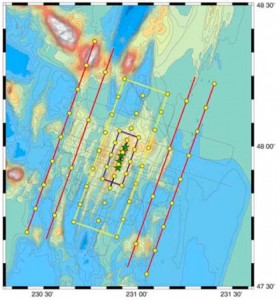Testing models of magmatic and hydrothermal segmentation
A 3-D seismic tomography experiment at the Endeavour Ridge
Collaborative research with Douglas Toomey (UO) and William Wilcock (UW). Competing models for what controls the segmentation and intensity of ridge crest processes are at odds on the scale of mantle and crustal magmatic segmentation, the distribution of hydrothermal venting with respect to a volcanic segment and the properties of the thermal boundary layer that transports energy between the magmatic and hydrothermal systems. The recent discovery of an axial magma chamber (AMC) reflector beneath the Endeavour segment of the Juan de Fuca ridge, as well as systematic along axis changes in seafloor depth, ridge crest morphology and hydrothermal venting provide an ideal target for testing conflicting hypotheses.
Our seismic experiment investigates the 3-D structure of the crust and topmost mantle beneath the Endeavour segment, a RIDGE2000 Integrated Study Site (ISS). The scientific objectives are to: (1) Determine if the segmentation and intensity of the magma-hydrothermal systems at the Endeavour ridge are related to magma supply or to the magma plumbing between the mantle and crust, and (2) Constrain the thermal and magmatic structure underlying the Endeavour hydrothermal system in order to understand the patterns of energy transfer.
An active source seismic tomography experiment, using an array of 64 three-component ocean-bottom seismometers, imaged the 3-D seismic structure of the crust and topmost mantle along an 80-km-long section of the Endeavour ridge. The experiment imaged four targets: (1) crustal thickness variations within 25 km of the axial high (0 to 900 kyr); (2) the 2-D (i.e., map view) structure of the uppermost mantle beneath the spreading axis; (3) the 3-D structure of the crustal magmatic system and (4) the detailed 3-D, shallow crustal thermal structure beneath the Endeavour vent field. The results of imaging defines the recent history of magma supply, the pattern of melt delivery from the mantle to the crust and the structure and segmentation of the subseafloor magmatic and hydrothermal systems. These measurements were used to testing critically competing hypotheses for what regulates the intensity of ridge crest magmatic and hydrothermal processes.

*Arnoux, G.M., D.R. Toomey, E.E.E. Hooft, W.S.D. Wilcock, J. Morgan, M.Warner, and B. P. VanderBeek, Seismic evidence that black smoker heat flux is influenced by localized magma replenishment and associated increases in crustal permeability, Geophys. Res. Lett., 44, doi:10.1002/2016GL071990, 2017
*VanderBeek, B., D.R. Toomey, E.E.E. Hooft, and W.S.D. Wilcock, Segmentation of mid-ocean ridges attributed to oblique mantle divergence, Nature Geosci.,9, doi:10.1038/NGEO2745, 2016.
*Soule, D., W.S.D. Wilcock, D.R. Toomey, E.E.E. Hooft, and R.T. Weekly, Near-axis crustal structure and thickness of the Endeavour Segment, Juan de Fuca Ridge, Geophys. Res. Lett., 43, doi:10.1002/2016GL068182, 2016.
Morgan, J., M. Warner, G. Arnoux, E. Hooft, D. Toomey, B. VanderBeek, W. Wilcock, Next-generation seismic experiments – II: wide-angle, multi-azimuth, 3-D, full-waveform inversion of sparse field data, Geophys. Jour. Internl, 204, 1342-1363, doi: 10.1093/gji/ggv513, 2016.
